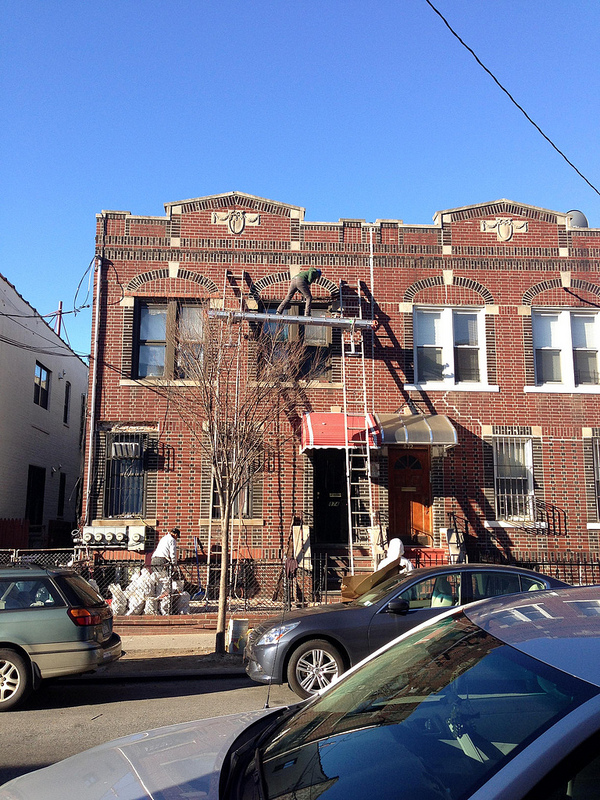How many safety violations can you see in this photo? #HazardSpotting
New York is a busy, bustling city, and sometimes when you stop to smell the roses, you catch sight of some disturbing thorns. One recent morning walk in my quiet residential neighborhood of Brooklyn brought me across the following perilous scene.
My first thought was for my own safety; I was walking on that side of the street and a worker was sweeping bits of shattered brick off the sidewalk as they fell from above. I crossed the street and assessed the scene. Now, as one of our resident OSHA enthusiasts who’s done her fair share of research on the topic, I spotted the following safety violations right away:
- Improper scaffolding: This is the most egregious violation in our scene, and the most dangerous. In fact, that isn’t scaffolding at all. It’s two ladders, hooked to a third horizontal ladder and the worker is clambering across them. OSHA regulations for mobile ladders and scaffolds are very specific about requirements for any platform higher than ten feet above the ground. They must have toeboards and guard rails. It doesn’t even address ad hoc jumbled ladders posed as legitimate working platforms.
- Lack of fall protection equipment: It doesn’t take much for a serious fall to happen, and it doesn’t require a great height for a serious fall to be fatal. In Atlantic City just a few weeks ago, the owner of a contracting business fell from the roof of one of his projects and died; presumably as the owner of a construction company he knew that fall protection is required by OSHA for any height greater than six feet in construction industry settings, but perhaps he got complacent from years of clambering across sites. That complacency cost him his life.
- Lack of personal protective equipment (PPE): None of the workers outside the building were wearing hard hats, much less masks to protect their lungs from brick or masonry dust as they chipped away at bricks above the lintel. Hard hats are one of the most straightforward preventative steps for falling or flying debris, and yet, I can’t count how many laborers I see around Brooklyn residential projects, just like these guys, not wearing them at all. And simple surgical face masks can still go a long way to protect against lead that might be present in the mortar, or brick dust, or possibly even silica (which is much more serious).
- Falling debris hazard: As I nearly experienced first-hand, the work being done on that ladder caused masonry to fall below, sometimes jettisoning out to the sidewalk. They even had a laborer posted there to sweep the remains, which is admirable from a cleanliness perspective but otherwise dangerous. OSHA requires that overhead work be clearly marked out with caution signs and barricades, and also suggests debris nets or catching platforms as necessary. This may be minor facade work, but as you can see in the window on the left, the whole row of bricks removed while replacing the lintels have to go somewhere, and onto a passerby’s head is not ideal.
These few hazardous violations that were present in just one construction project, with three laborers at risk, made me concerned for the entire project; these workers deserve to be in an environment that pays heed to their safety even when it’s a small residential project. I called 311 and reported it to the Department of Buildings, although so often those calls bring out an inspector far too late for any real reparations to be made. And it got us here at MySafetySign thinking about the safety violations we see around us every day. What can we do about them? What should the construction industry be on the lookout for, in their own job sites and work environments? We’re pretty good at spotting good and bad worksite conditions, but what can we use to educate readers about safety?
So with this inaugural (and somewhat cranky) post, we’re starting a new initiative here at MySafetySign: Hazard Spotting. If you send us pictures of potential safety violations via email, Facebook, or tweet using the #HazardSpotting hashtag, we’ll write a post just like this one. It’s like they say: “If you see something, say something.” We’ll investigate the photo with our crack team of regulatory nerds, and report back on the blog what we find.
Category: #HazardSpotting, Safety Tips
















